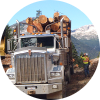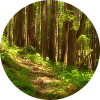You can download the PDF file here:
Wood Post Aug 2020
Old Growth Forest Management
In this issue, we would like to focus on how old growth forests are managed in the Community Forest.
Old growth forests are of special value for a variety of reasons including biodiversity, unique habitats and aesthetic beauty. With trees many hundreds of years old, they generate a sense of awe and wonder for a natural environment untouched by the modern world. Old forests can also contain highly valued wood important for rural economic development. Given these attributes it is no surprise that the management of old growth is controversial.
Some of this controversy stems from different perspectives on what is ‘old growth’. Technically, old growth was defined as forests older than 250 years, but now, old growth forests are defined not just by age but also by certain attributes that capture the ‘old’ state. These attributes include a variety of tree sizes and ages, multi storied canopy, well developed understory plant community, canopy gaps and trees in various stages of health and decay. Many of these stand
attributes develop earlier than 250 years and some people believe anything older than 100 years is old growth. However, our forests are still going through developing stages at that age and the exact age of when a forest reaches it’s old, climax state varies.
Currently, our forest inventory does not capture all the old growth qualities and so, for analytical purposes, age is still used as the main attribute to identify where old growth is located. It is a fair assumption that forests over 250 years in age will have the attributes
associated with old growth.
In BC, old growth is managed in a number of different ways to ensure a natural forest legacy. Old growth is directly protected in parks and specially designated Old Growth Management Areas. There are also provincial limits on how much old growth must be maintained across ecosystems and
landscapes. In certain areas, like the Great Bear Rainforest, there are stricter limits on how much old growth needs to be maintained.
Here in the Central Coast, we are fortunate that most of the forest remain as old growth and with huge tracts of land set aside as parks and conservancies, this is virtually guaranteed in perpetuity.
The review on the proceeding pages demonstrates that there will always be a significant amount of old growth in the Community Forest. If harvesting continues at the same pace and barring any
catastrophic fires or insect epidemics, the amount of old growth will actually increase over time, not decrease. Furthermore, given that today’s forestry practices provide more riparian and habitat protection, low elevation riparian forests previously logged will not be logged in the future and so those areas will continue to grow and return to their old natural state.
BCCFL volunteer Directors are:
Rod Krimmer, President
Ed Wilson, Vice-President
Troy Gurr, Treasurer
Barry Brekke
Mark Nelson
Keith Boutwell
Wayne Bittner
Did you know –
It takes approximately 42 trees to make a 2000 sq ft house?
New Hwy Sign
Driving through Hagensborg you will note a new sign by the side of the highway showing the location of the Community Forest office on Hagensborg Road. The sign is intended to be multi purpose by showing what the current fire danger rating is and any associated burning restrictions. There is also the option to hang other short public information notices. Contact our office to
see about posting a notice.
Local contractor Black Sheep Timbers won the contract to construct the sign and it is another great example of the kind of products made out of wood from the Community Forest.
2020 Operations
The first half of 2020 has been very busy despite the COVID-19 pandemic crisis. The West Chilcotin pulp project continued through the winter and in March, over 15,000 m3 were sent away by barge. In April, we provided bundling and booming services for some private land logging. In May we finished off the block in Nusatsum that was started in the previous year. Also in May, under contract to the Ministry of Forests, we replaced all the wood timbers and decking on the aging Talchacko Bridge, giving it another 30 plus years of life. Once the bridge was complete,
we resumed operations in Noomst where we left off last year. We expect to be busy at Noomst well into the fall.
The second half of the year is expected to be equally busy. Nuxalk Forestry has begun logging in Talchacko and we will be providing bundling and booming services to assist with their log transportation. In July, the Chilcotin pulp project got going again and after a short break in August, we expect to be receiving pulp into late fall. If time permits, then we may log a small block in east Salloompt, near the start of the Lost Lake trail. As part of mobilizing for that project, we will do some seriously needed road maintenance on the Lost Lake Forest Service Road.
Firewood
Fall is coming and we encourage people to collect as much firewood as they can from areas where operations are complete. Currently, the best areas for firewood are at the start of Noomst and South East Nusatsum (take West Nusatsum Forest Road to 13 km then take left Spur Road north for 2
km). We are operating in back end of Noomst so best time to get firewood is after 4:00 pm or on weekends. In late October – November, we will likely burn the remaining slash piles to reduce fuel
loading.
CONTACT US
If you have any questions, please contact us:
General Manager, Hans Granander, RPF
1893 Hagensborg Road
PO Box 189
Hagensborg, BC V0T 1H0
250-982-2131
Email: gmbccfl@gmail.com
Website: www.bccfl.com



